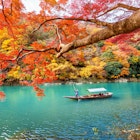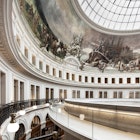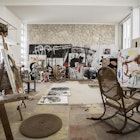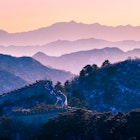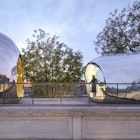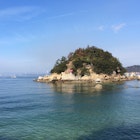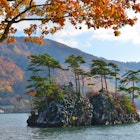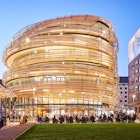After the Nervion River flooded in 1983, the industrial seaport of Bilbao presented a blank canvas, and was reimagined as the artistic centre of the Spanish Basque Country, hosting the famous Guggenheim Museum Bilbao and a litany of other attractions.

A city transformed
While credit for Bilbao’s modern rebirth is often rightfully applied to the Guggenheim effect (or as it is more accurately described, the Bilbao effect), the phenomenon would be virtually impossible to replicate in any other city given the unique circumstances in which it took place. Faced with the mission to rebuild, the industrial centre made an avant-garde gambit that led to its revival as a cultural hub of art and design.
The centrepiece of that transformation is the celebrated Guggenheim Museum Bilbao, designed by the master architect Canadian-born American Frank Gehry. Inaugurated by Spain’s King Juan Carlos I and Queen Sofia, the building itself is a piece of art worthy of the works it houses. With a confounding facade of bending titanium, limestone and glass, it is considered an iconic architectural triumph and was an immediate success upon opening in 1997.
Resembling a boat’s mast rising from along the river, harking back to Bilbao’s industrial origins, the Guggenheim’s unfolding structure reveals a blossoming flower from above. Completed on time and budget, thanks to advances in computer design and Gehry’s thoughtful planning and resourcing, the museum drew 4 million visitors in just its first three years, easily satisfying the cost of construction. The Guggenheim continues to draw increasing crowds, and now welcomes over 1 million visitors annually.
Around the Guggenheim
At the Guggenheim’s entrance, American artist Jeff Koons’ 40-foot tall Puppy has stood guard dutifully since 1992. A symbol of the city, the giant flowered West Highland White Terrier sculpture is meticulously maintained. Twice annually, in May and October, in a process that takes nine days to complete, a crew of 20 replenishes the nearly 40,000 flowers with fresh seasonal varieties: pansies for the fall and winter, begonia, impatiens and petunias for spring and summer. Another perennial Koons classic, Tulips, is on the museum’s back deck facing the river.
The 30-foot-tall Maman spider sculpture crawls along the river’s edge just outside the Guggenheim. One of French-American artist Louise Bourgeois’ most ambitious works, the arachnid is cast of bronze and stainless steel, with marble eggs. Crafted as a tribute to her mother, a weaver, it was installed in 1999. Seven other permanent iterations of the eight-legged sculptures are spread at sites around the world, such as Mori Art Museum in Tokyo, Japan, and a stainless steel variation at the Tate Modern in London, England.
Read more: 20 museums to put on your bucket list
The curving metal exteriors of Gehry’s architectural designs are complemented with a sculpture by British-Indian artist Anish Kapoor. Placed in the Guggenheim’s fountain, the mirrored globes of The Tall Tree & The Eye reflect the museum into seemingly endless universes.
The fountain is home to two unique site-specific installations. Fire Fountain, an imposing display of flames, was envisioned by the French artist Yves Klein before his 1962 death but was not completed until 1997. Creating the effect of a fiery moat, it lights up the river-facing facade of the Guggenheim nightly. Also using the fountain as a canvas is Japanese artist Fujiko Nakaya’s 1998 contribution Fog Sculpture #08025 (F.O.G.), notably the first sculpture to use fog as a medium, generated by a high-pressure pump/motor system.
The interplay between the riverfront’s many interactive art installations makes for a constantly changing experience and remains a popular meeting spot to watch the sunset.
Inside the Guggenheim
Within the museum, several familiar exhibitions are housed. American artist Richard Serra’s The Matter of Time, a permanent display occupying the grand scaled gallery 104, consists of a maze of eight pieces of torqued ellipses made of gigantic strips of steel, so massive that visitors can walk within the sculpture’s curved walls.
Installation for Bilbao by American visual-projection artist Jenny Holzer was produced specifically for the city in 1997 and features slogans from Holzer’s “Truisms” across nine columns of electronic LEDs. A friend of the museum, her projections have appeared on the Guggenheim’s facade along the river and in 2019 it played host to the artist’s largest-ever exhibition, the 40-year-retrospective Jenny Holzer: Thing Indescribable.
Read more: The world's strangest museums
Located on a quiet outdoor terrace at the Guggenheim, Wish Tree for Bilbao is an olive tree gifted to the city by Yoko Ono as part of an ongoing participatory work inspired by her childhood memories of Japan and the tradition of hanging prayers in gardens.
The written wishes from similar trees installed around the world are collected and housed in Imagine Peace Tower on Viðey Island, in Reykjavík, Iceland, in honour of her late husband John Lennon. Symbolic of their combined efforts for world peace, the Guggenheim’s tree accepts wishes alternating in form between written notes and spoken whispers.

Art and design around Bilbao
Bisecting the Guggenheim, La Salve Bridge was originally built in the 1970s and garnered the honoured title of “Prince and Princess of Spain Bridge”, heralded as a traditional spot of prayer for returning seafarers. On the 10th anniversary of the museum, a red-crowned accent designed by French sculptor Daniel Buren was inaugurated. Standing as a bold entrance into the reimagined city, the modernist gate performs a nightly light show.
The sophisticated waterfront design made an appearance in the 1999 James Bond film The World is Not Enough. After escaping a meeting gone awry via a zip line out the window, Bond drops down to street-level in view of Koons’ Puppy while he swiftly makes his way across La Salve Bridge.
Just a few steps from the Guggenheim, Salvador Dalí’s TERPSÍCORE was designed specifically for Bilbao and stands in a fountain adjacent to the Euskalduna Palace Conference Centre. The Spanish surrealist may be more closely associated with his home in Catalonia, but his passion for northern Spain is on full display in the melting 4,000-pound figure that appears to dance gracefully along the fountain’s surface.
Across the river from the Conference Centre is the impressive Tiger building, crowned with a grandiose concrete sculpture of a tiger by sculptor Joaquín Lucarini. Lucarini was commissioned to sculpt the imposing feline form in 1942, predating the flood and unknowingly sowing the seeds for Bilbao’s riverfront as a future art haven.
The Guggenheim has made the city a magnet for modern urban design innovation. As the museum was being constructed, Bilbao’s metro stations were also undergoing a re-envisioning by English architect Norman Foster. The open and inviting glass tunnels have become affectionately known as “Fosteritos”, the signature entrances designed to guide commuters seamlessly from street level.
Read more: The world’s first travel guide is on display at the British Museum
The Bilbao Fine Arts Museum was established in 1914 and over its history has amassed one of the richest collections in Spain, consisting of over 10,000 works. Not to be overlooked, the museum is located close by the Guggenheim in the Doña Casilda Iturrizar park.
Home to football club Athletic Bilbao, San Mames Stadium is situated on a high bank along the river and opened in 2010. It was designed with a sophisticated lighting system that allows the distinctive exterior panels to be lit with complex animated designs.
